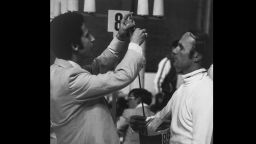Story highlights
Olympic scandals are as old as the Games themselves
Cheating takes creative forms but most often involves doping
In reaching for the gold, many will falter and fail. Some will cheat.
Entire countries can fall into disgrace, as with the East Germans in the ’70s and the current doping allegations about the Russian team in Rio.
History is full of such Olympic scandals, starting with the advent of the Games in ancient Greece.
Olympic Games
“In the name of all the competitors I promise that we shall take part in these Olympic Games, respecting and abiding by the rules which govern them, committing ourselves to a sport without doping and without drugs, in the true spirit of sportsmanship, for the glory of sport and the honour of our teams.”
Today’s Olympic oath is modeled on the one taken by the first Olympic athletes 3,000 years ago. Back then, they didn’t hold the Olympic flag while reciting the words. Instead, their hands were full of animal flesh, sacrificed before a terrifying statue of Zeus wielding thunderbolts. It was a symbol of what might lay in store from the gods if an Olympic contender were to break his sacred vow.
Of course, that oath didn’t resonate with everyone, and Olympic doping was born.

Caffeine-rich drinks, brandy and exotic meats such lizard’s flesh became the performance-enhancing drugs of ancient Greece. Wrestlers, using powder to protect their bare bodies from the sun, would sometimes add oil to make themselves slippery during a match.
Bribery was common, too. Eupholus, a boxer from Thessaly, was one of the more well-known offenders. In the 388 B.C. Games, he bribed three opponents to take a dive to ensure his win. Such offenses were punished with a fine, and the money was used to erect zanes, bronze statues of Zeus (PDF), along the path to the stadium in Olympia. Each statue had the name of the cheater and his offense inscribed at the base. Eupolus’s fines were so large that it’s said he had six bronze statues erected in front of the stadium.
It wasn’t long until those statues were joined by many more.
Modern shortcuts to gold
Like in ancient times, not all doping in the modern Games involved dope. Take the case of American distance runner Fred Lorz. After he crossed the finish line in the 1904 St. Louis Olympic marathon to thunderous applause, it was discovered that Lorz had hitched a ride in a car for 11 of the 25 miles of the race.

Then there’s the imaginative ruse used in the 1984 Olympics by Puerto Rican runner Madeline de Jesús. After she was injured competing in the long jump, she talked fellow athlete and identical twin sister Margaret into running her qualifying race for the 4x400-meter relay. The deception worked, and the team advanced. But when her coach found out, he pulled the Puerto Rican team out of the final.
And in an early use of technological cheating during the 1976 summer Olympics, Soviet fencer Boris Onischenko installed a button in his rapier that would falsely register a point on the electronic scoreboard when he triggered it.

He was winning when he pushed the button accidentally just as his opponent, English team captain Jim Fox, was retreating and nowhere near the blade. Crying foul, Fox asked officials to examine the épée; the technology was so well-hidden that they had to dismantle the weapon to find the elaborate wiring.
Performance-enhancing drugs: A long list of cheaters
But most Olympians who cheat aren’t that creative. Today’s modern deceptions normally involve drugs, especially the performance-enhancing type. The most popular are darbepoetin, which boosts red blood cells that deliver oxygen to muscles; diuretics such as furosemide to lower body weight; human growth hormones such as somatotropin and anabolic steroids such as stanozolol and THG.

When the International Olympic Committee began drug testing in 1968, the first athlete to be disqualified was Swedish pentathlete Hans-Grunner Lijenwall in that year’s Mexico City Games. Surprisingly, his drug of choice wasn’t very performance-enhancing: He was drunk. He told officials he’d had a couple of beers to calm his nerves before competition.
The IOC says it normally tests the top five finishers in each medal event, plus two at random. But all athletes in the Olympic Village are also subject to random testing, with no advance notice. And just in case the labs miss something, all blood and urine samples are frozen and stored in Switzerland and can be retested with improved technology or when allegations of doping arise.
Over the years, that’s gotten a lot of athletes in trouble, and medals have been revoked days and even years after their owner has taken them home to fame and fortune. In March of this year, for example, six Russian track and field athletes lost all of the medals they had won between 2008 and 2013 after an independent commission suggested retesting.

In numbers, men’s weightlifting currently has the dubious honor of having the most medals removed: over 15, many of them from Bulgaria and other former Eastern bloc countries. That record is not so closely followed by Russia’s female cross-country skiing team, who lost five, and a single American athlete, Marion Jones.
Jones become the first woman to win five track and field medals at a single Olympics in 2000 in Sydney, taking three gold and two bronze. She repeatedly denied allegations of steroid use before finally admitting in 2007 to lying to federal investigators, a crime. She served six months in jail and was forced to return all five medals.
Canadian sprinter Ben Johnson smashed a world record to win the 100-meter dash in the 1988 Seoul Olympics, only to have it removed the next day after he tested positive for the steroid stanozolol. American Carl Lewis became the new gold medal winner.

And perhaps the most well-known example of Olympic cheating is Lance Armstrong, stripped of his 2000 bronze medal as well as all of his Tour de France titles after admitting he’d been a chronic doper throughout his career.
But not all of the cheating in modern Olympics was done by the athletes themselves. After the fall of the Berlin Wall in 1989, the truth about the German Democratic Republic’s systematic doping of its Olympic athletes came to light. Documents proved what many had long suspected: The massive medal wins by the those athletes since the early 1970s were not always based on natural physical prowess.
Called “State Planning Theme 14.25” and administered in conjunction with the Stasi, or secret police, German athletes were given “vitamin pills” (aka large doses of steroids) by their coaches and doctors without their knowledge. Girls and young women were especially victimized, taking larger doses of androgenic steroids and testosterone than their male counterparts.

Court cases brought by victims show a litany of damage, including breast malformations, ovarian cysts, heart attacks, liver and kidney damage, cancer and sometimes even death. That’s in addition to the sexual side effects of large doses of testosterone-laced steroids.
Heidi Krieger was a champion German shot putter who won gold in 1986 at the European Athletics Championships. The excessive use of steroids so altered her physically that she opted to have a sex change operation. Today, he is known as Andreas Krieger and has shared his story in a film.
Follow CNN Health on Facebook and Twitter
About 200 of the thousands of athletes given steroids by the German Democratic Republic have been given a one-time payment of 10,000 euro by the German government; others sued Jenapharm, the government-run pharmaceutical company that made Oral-Turinabol, the steroid they were given. A few of the coaches and doctors involved in State Planning Theme 14.25 were convinced in court of causing bodily harm but served little time.









